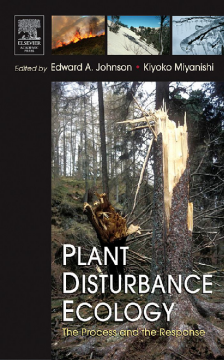
Additional Information
Book Details
Abstract
The media coverage of natural disasters (hurricanes, fires, floods, ice storms, etc.) indicates the prevalence of natural disasters in most, if not all, ecosystems. In order for scientists to study, understand, and ultimately predict how these disturbances affect ecosystems, it is necessary for them to know more about the physical processes involved in these disturbances and to learn how to couple these processes to the ecological systems. Essential for all ecologists, forest researchers, and conservation biologists, this book includes chapters on the disturbance processes, how the disturbance causes necrosis or death to individuals, and their effects on population or community processes. In Plant Disturbance Ecology, physical scientists who study disturbances provide an introduction to the physical disturbance processes, while ecologists relate this information to the way the vegetation responds to the disturbances. This reference is also key for all researchers hydrology, geomorphology, and environmental management.
- Includes coverage on six different disturbance processes: Wind, Gravity, Geomorphic, Hydrologic, Combustion, and Biotic
- Provides a clear explanation of how some of the physical processes of disturbance affect plant ecological processes
- Offers ecologists an up-to-date understanding of the physical processes and allows them to predict future affects of disturbances
- Unites two related fields by linking the disturbance processes and ecological responses
- Presents physical scientists with ideas of how they might usefully apply their knowledge to advance understanding of ecological systems
"The process by which vegetation changes over time has fascinated plant ecologists for at least a century. Early theories emphasized slow, steady change to a hypothetical stable 'climax' community. By the 1970s, ecologists began to realize that disturbance was the rule, not the exception, and a rather radical shift in thinking about vegetation took hold. This multidisciplinary compendium seeks to move what might be called disturbance science beyond descriptive approaches to look at how particular physical disturbances actually cause particular ecological effects. The many authors cover, e.g., the specifics of how forces like wind (turbulence, microbursts, etc.) can physically cause stem breakage in trees. Other modes of disturbance treated here include ice storm damage to forests and trees; dynamic processes that affect coastal dunes; fluvial processes related to riparian tree growth; the effects of water-level changes in ponds and lakes; heating effects on vegetation; fire's effects on grasslands and trees; a variety of insect impacts on different systems; and the impact of beavers on woody vegetation. The level of technical detail in the chapters varies greatly, and a few rely heavily on mathematical formulas. Other chapters are essentially literature reviews. Plant ecologists with a process- or mechanistically oriented approach to understanding vegetation change will appreciate this book. Summing Up: Recommended. Upper-level undergraduates and above." --CHOICE
